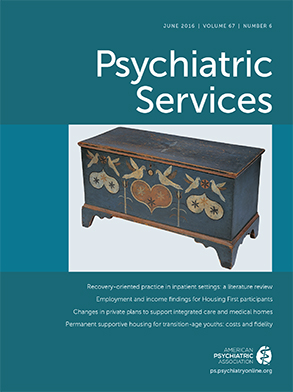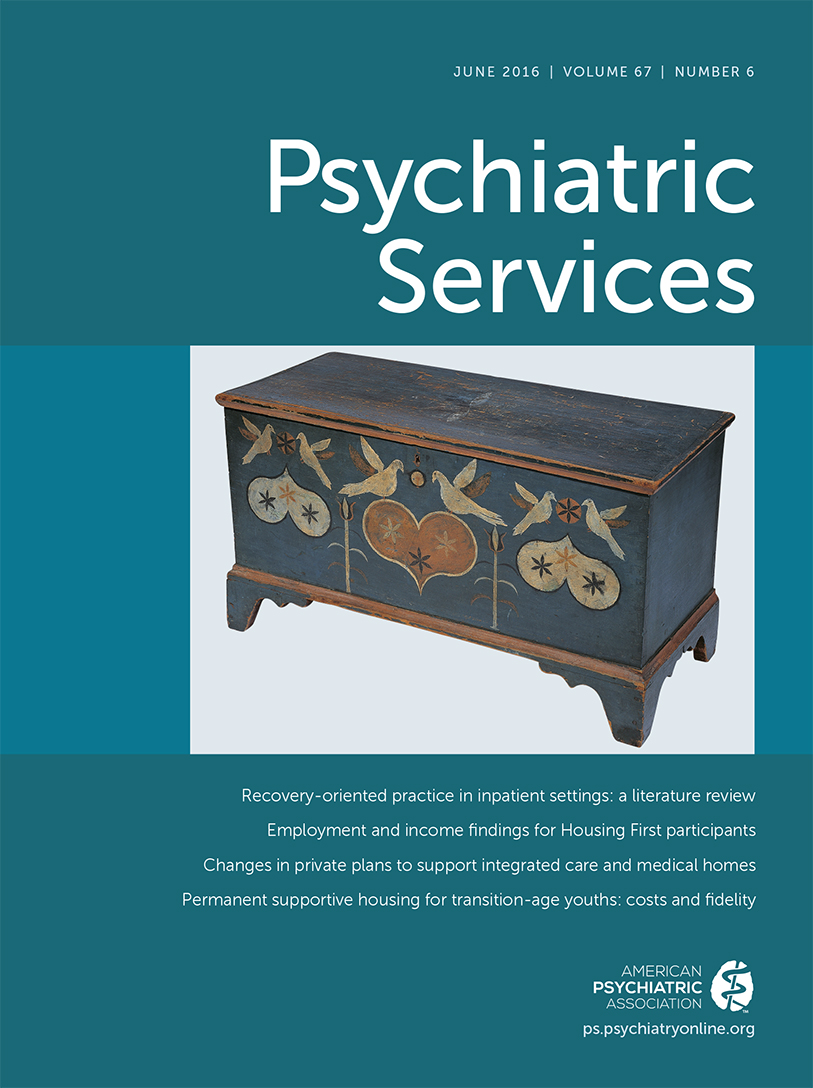Robust research has shown that high-fidelity individual placement and support (IPS) benefits most people with mental illness who want to find work (
1). The results of these analyses indicate that IPS produces superior outcomes compared with other vocational programs and that the beneficial effects of IPS are generalizable.
The finding that IPS can benefit a wide range of individuals, including people who have been homeless, has important implications for service implementation, considering that 55% to 78% of persons with mental illness want to work (
2,
3). Much of the research involving people who are homeless has focused on disabilities rather than strengths, so the desire for employment and employment support in this population has not been estimated frequently. The desire for full- or part-time employment among people who are homeless has been estimated at 87% (
4), and qualitative research suggests that this population prefers competitive employment rather than welfare (
5). Nevertheless, there is a perception that the experience of homelessness is associated with reduced employment potential, and this perception may be particularly detrimental for people with a mental illness (
6), who face the added pressure of self-stigmatization. Therefore, persons with mental illness who are homeless may benefit from goal-oriented services (
7).
With such a large proportion of this population desiring employment, it is important to evaluate whether the types of services known to be effective in promoting employment among stably housed persons with mental illness are likely to be acceptable to people who are or have recently been homeless. Accurate evaluation is especially important considering that critics of the IPS literature have argued that the desire to work and the desire for assistance finding work among people with mental illness in general have been overestimated (
8). It is important to understand the actual numbers of individuals who are likely to use services; by doing so, services can be designed to reach potential service users who might otherwise not be considered (
8).
This study focused on the desire for work among individuals with mental illness and a recent history of homelessness and analyzed the differences between people who accepted or declined randomization to a controlled trial of IPS. It may be hypothesized that participants who believed that they did not need help obtaining employment would decline randomization and the possibility of receiving employment-related services. If self-appraised ability to find work was accurate, these individuals would have the ability to find work on their own and thus have greater odds of obtaining employment compared with participants who accepted randomization to an IPS program. These analyses shed light on the characteristics of participants who declined IPS services, an underdeveloped area in the literature.
Methods
The At Home/Chez Soi study was a multisite randomized controlled trial (RCT) examining the effects of Housing First on a sample of adults with a history of homelessness and mental illness. Participants were offered assistance finding and keeping stable private accommodations (
9). At one site, participants were invited to participate in a substudy to evaluate the effects of IPS services (unpublished data, Poremski D, Rabouin D, Latimer E, 2015). [A table listing inclusion criteria of the study and substudy is available as an
online supplement to this report.]
At baseline, experienced, full-time interviewers asked participants whether they desired paid employment. Interviewers then collected demographic information, determined diagnosis with the Mini International Neuropsychiatric Interview, and administered the Recovery Assessment Scale (RAS) (
10) and the Community Integration Scale (CIS) (
11). At the end of the interview, participants in the experimental group of the Housing First RCT (N=204) were eligible to be randomized to the IPS RCT substudy; 194 were considered in the present study. Participants were categorized according to whether their choice to accept randomization to the IPS substudy was concordant with a desire for work.
As part of the larger study, employment and housing stability data were collected at three-month intervals for all participants, including those who declined randomization to the IPS substudy. Ethics approval was obtained from the Ethics Review Board at the Douglas Institute, which is affiliated with McGill University in Montreal, Quebec, Canada.
Baseline characteristics of the participants who accepted randomization to the IPS substudy were compared with those who declined randomization. [A summary of statistical methods used in the study is available in the online supplement.] An alpha of .05 was used.
A logistic regression model estimated via generalized estimating equations (GEE) (
12) was applied to determine if participants who declined randomization but wanted work had greater odds of obtaining work compared with participants who accepted randomization and wanted work. The dependent variable was a binary indicator of whether the participant had worked during 30-day segments over the 24-month study period. Housing status (defined in the
online supplement) was used as a lagged time–dependent covariate (
12). Analyses were conducted in Stata 13 (
13).
Results
Of the 194 participants, 133 (69%) expressed a desire for work, but of those, only 75 (56%) agreed to be randomized to IPS services. [A table summarizing the entire distribution of participants’ responses to the offer of randomization is available in the online supplement.]
Several characteristics differentiated participants who accepted or declined randomization to IPS services. Participants who accepted randomization to IPS services tended to be younger, had more years of education, had more arrests in the past six months, and spent less time in stable, private accommodations and more days in emergency shelters in the 90 days preceding study enrollment. [A table summarizing demographic characteristics, including data on race-ethnicity, and CIS and RAS scores by choice to accept or decline randomization is available in the online supplement.]
Table 1 presents the demographic characteristics of persons who accepted or declined participation in the IPS substudy according to their desire for work. The analyses excluded 25 participants who gave no answer or who were undecided about wanting employment and included only variables that were significant or approached significance in comparisons of all participants who accepted or declined randomization to avoid multiplicity of statistical tests.
Of those who wanted employment, the adjusted odds of obtaining employment were significantly lower in the group that declined randomization (odds ratio=.42, 95% confidence interval=.20–.88, p=.022). [The complete results of the regression model estimated via GEE are presented in the online supplement.]
Discussion and Conclusions
This exploratory study contributes to the literature by documenting the desire for work in a sample of people with a recent history of homelessness who have a mental illness and by examining the characteristics and outcomes of people who declined randomization to a supported-employment trial. This group is habitually underdocumented in the literature.
Sixty-nine percent of our participants expressed a desire for employment. This is in line with past estimates of the percentage of persons with a desire to work in a stably housed population of individuals with mental illness, between 55% and 78% (
2,
3), but below the estimated percentage (87%) of people who are homeless who desire to work (
4).
Counter to our hypothesis, participants who wanted work but declined randomization had lower odds of obtaining employment compared with participants who wanted work and accepted randomization. These participants had fewer of the characteristics identified as barriers to employment in the literature (
6): fewer had a criminal record and they had shorter periods of homelessness. However, they had fewer years of education, which is considered a barrier to unemployment. The fact that they were unable to obtain employment on their own suggests that they may benefit from goal-specific help. Although persons who declined to participate may never have come into contact with supported-employment services, they represented approximately half of the sample, possibly a large portion of the target population who could benefit from support returning to work.
In order to help persons who want work in their community but decline the possibility of help, service providers must find a way of presenting their services in a way that highlights the advantages of the service, including its flexible and collaborative nature, while acknowledging the possible obstacles to employment (
7). Further qualitative research may be necessary to gain a deeper understanding of why certain people who want to work decline employment services and determine which services may be suitable for them.
These findings should be interpreted with the following considerations in mind. We have interpreted participants’ decision to decline randomization to the IPS trial as a lack of interest in receiving IPS services. Using their response to the offer of randomization as an indicator of their desire for support may have less face validity than directly asking participants if they want IPS services but may be a better indicator of desire because it is based on actual actions. Another interpretation of their decision could be a disinterest in participating in additional research. A second consideration is participants’ involvement with the supported-housing project, which subsidized approximately $360 of their monthly rent, possibly influencing their choices by reducing the financial burden of unemployment. Finally, the entire group was asked once, at the beginning of the project, about their desire to return to work. It is possible that participants who wanted work but declined randomization eventually changed their minds, deciding to no longer pursue employment.
Acknowledgments
The authors thank the Montreal site lead researcher Eric Latimer, Ph.D., research coordinators Cécile Leclercq, Ph.D., and Véronique Denis, M.Sc., the team of interviewers, the individual placement and support staff and management, and the participants.

